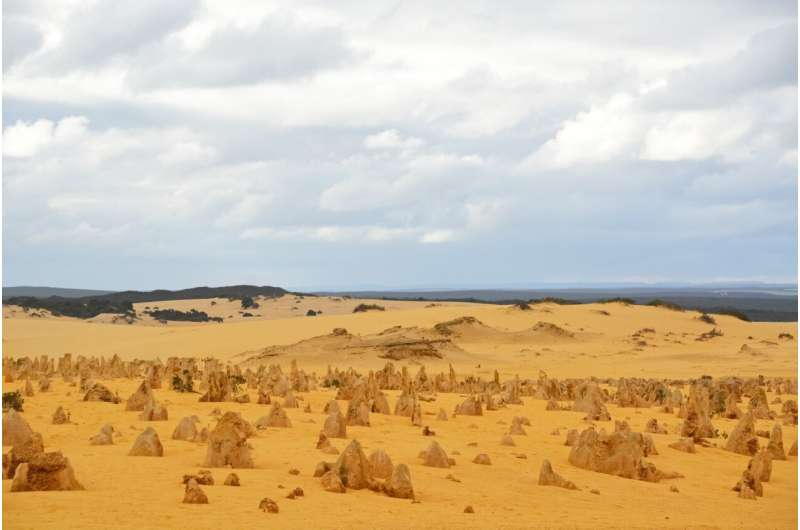
The western U.S., particularly the Southwest, has experienced a notable increase in record-breaking high temperatures over recent decades, with recurring drought and heat waves. These conditions have resulted in severe consequences for both human and nature systems, including dire water shortages, rampant wildfires, substantial agricultural losses, and increased human mortality.
These regions, dominated by water-limited ecosystems, face exacerbated water stress due to more frequent and protracted droughts and heat waves, which can profoundly impair ecosystem photosynthesis and carbon uptake, in turn affecting the global carbon cycle.
Investigating vegetation photosynthesis at various time scales provides valuable insights into vegetation growth, carbon uptake, and environmental interactions. Traditional polar-orbiting satellite observations have aided in monitoring gross primary production (GPP) at longer scales (e.g., monthly, annual), but they are limited in capturing diurnal variations.
Fortunately, in recent years, emerging new-generation geostationary satellites with sub-daily sampling capability, provide unique opportunities to study diurnal variations of vegetation photosynthesis and their responses to environmental conditions over the course of day at large spatial scales.
In a recent study, scientists estimated hourly GPP across the Conterminous U.S. based on observations from Geostationary Operational Environmental Satellite-R (GOES-R), and then investigated how the diurnal cycle of photosynthesis responded to the severe late-summer heat wave of 2020. The work is published in the journal Science Advances.
The study provides an exploration of heat wave impacts on the diurnal dynamics of photosynthesis at a continental scale, revealing a widespread midday and afternoon depression of photosynthesis in dryland ecosystems during the heat wave. In the study the researchers examine the environmental regulation of diurnal photosynthesis dynamics across diverse ecosystems, and illustrate how current radiation-based methods for upscaling polar-orbiting satellite snapshots to daily means may under- or overestimate daily GPP.
Widespread midday and afternoon depression in ecosystem photosynthesis during the heat wave
They found a widespread midday and afternoon depression in ecosystem photosynthesis during the heat wave in the western United States. Diurnal centroid (CGPP) and peak hour of GPP shift toward earlier morning for the majority of the western regions, and the ratio of afternoon GPP to morning GPP also shows a marked decline.
The shift in diurnal metrics positively correlates to the daily GPP change, implying that the morning shift in diurnal metrics generally results in a decrease in daily total GPP.
The diurnal metrics exhibit divergent responses to the heat wave across vegetation types and along aridity gradients. Overall, shrubland and grassland are more sensitive to the heat wave than the other vegetation types.
The impact of the heat wave on the diurnal cycle of photosynthesis is predominantly observed in arid and semiarid regions with an aridity index (AI) below 0.6. They found that the largest GPP loss occurred at noon or during the afternoon for the majority of western regions, later than the GPP peak hour during the heat wave year, further substantiating the asymmetric influence of heat waves on diurnal photosynthesis fluctuations.
Environmental controls on diurnal behavior of ecosystem photosynthesis
The regional-mean daily vapor pressure deficit (VPD) and land surface temperature (LST) show strong negative relationships with regional-mean CGPP, suggesting that the increase of heat and water stress contributes to an earlier coming of diurnal CGPP. The pixel-level relationships for different vegetation types show that shrubland has the strongest negative relationships and largest negative slopes between CGPP and VPD or LST among all the vegetation types, followed by evergreen needleleaf forest (ENF) and grassland.
Geostationary satellite-based method better estimates daily GPP and GPP loss during the heat wave
Researchers say their results demonstrate that using a snapshot from the earlier part of the morning (e.g., 8 a.m.), and solely considering radiation variations for daily upscaling, leads to an overestimation of daily GPP across the majority of the United States.
Conversely, using an afternoon observation for daily upscaling (e.g., 2 p.m.) results in an underestimation of daily GPP. The upscaling method relies only on radiation and does not account for changes induced by varying environmental stresses and light use efficiency throughout the day.
Biases stemming from the radiation-based upscaling method can also affect the calculation of GPP difference between normal and heat wave years. They further calculate the regional total daily GPP for drylands from 14 to 19 August for both years.
Both daily GPP upscaling from all single hours and GPP capture the decline of dryland productivity during the heat wave. The estimated GPP loss for the entire region during the heat wave period based on GOES-R is approximately 0.4 Tg C per day, while GPP loss based on upscaling from different hours ranges from 0.25 to 0.6 Tg C per day.
More information:
Xing Li et al, New-generation geostationary satellite reveals widespread midday depression in dryland photosynthesis during 2020 western U.S. heatwave, Science Advances (2023). DOI: 10.1126/sciadv.adi0775
Journal information:
Science Advances
Provided by
Seoul National University
Geostationary satellite reveals widespread midday depression in dryland photosynthesis during 2020 heat wave (2023, August 3)
retrieved 27 September 2023
from https://phys.org/news/2023-08-geostationary-satellite-reveals-widespread-midday.html
part may be reproduced without the written permission. The content is provided for information purposes only.